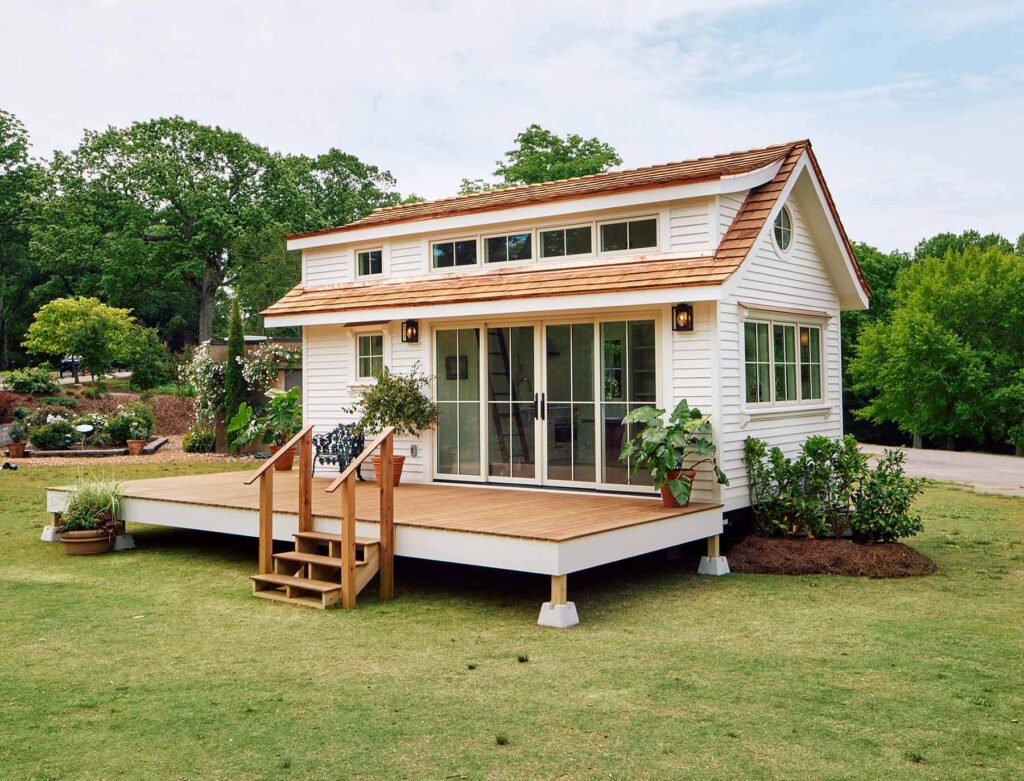Building a Tiny House
It Feels Like Home!

Building a Tiny House on Your Own Land: A Plan For Success!
Building a tiny house on your own land can be a rewarding project that offers a sustainable and affordable living solution. Whether you are looking to downsize, create a guest house, or simply embrace a minimalist lifestyle, this guide will take you through the essential steps to successfully build your tiny house.
Step 1: Planning and Research
Zoning and Building Codes:
- Check Local Regulations: Contact your local zoning office to understand the regulations, zoning laws, and building codes specific to tiny houses in your area. Some areas have minimum size requirements, restrictions on types of foundations, and specific zoning classifications.
- Permits: Determine what permits are required for construction. This may include building permits, electrical permits, plumbing permits, and more.
Budgeting:
- Estimate Costs: Plan your budget carefully, including costs for land preparation, materials, labor (if you’re hiring help), permits, utilities, and interior finishes.
- Contingency Fund: Set aside an additional 10-15% of your budget for unexpected expenses.
Design and Layout:
- Floor Plan: Create or choose a floor plan that maximizes space and functionality. Consider your lifestyle needs, such as sleeping arrangements, kitchen space, bathroom facilities, and storage.
- Style: Decide on the style and aesthetics of your tiny house, whether it’s modern, rustic, or traditional.
Step 2: Preparing the Land
Site Assessment:
- Location: Choose a location on your land that is level, accessible, and has good drainage.
- Utilities: Plan for access to utilities such as water, electricity, and sewage. This may involve connecting to municipal services or setting up off-grid solutions.
Clearing and Grading:
- Clear the Site: Remove any trees, rocks, or debris from the construction site.
- Level the Ground: Grade the land to ensure it is level and stable for building.
Foundation:
- Types of Foundations: Decide on the type of foundation for your tiny house. Options include concrete slabs, pier and beam, or skid foundations. Each type has its pros and cons, depending on your land and local regulations.
Step 3: Building the Structure
Materials:
- Quality Materials: Choose durable and high-quality materials that will ensure the longevity of your tiny house. This includes framing lumber, insulation, windows, doors, and roofing materials.
Framing:
- Build the Frame: Construct the floor, walls, and roof frame according to your design. Ensure all structural components are securely fastened and level.
- Sheathing: Add exterior sheathing to the walls and roof to provide structural stability and a base for siding and roofing materials.
Roofing:
- Install the Roof: Choose a roofing material that suits your climate and aesthetic preferences, such as metal, shingles, or tiles.
- Waterproofing: Ensure the roof is properly waterproofed with underlayment and flashing to prevent leaks.
Siding and Windows:
- Exterior Siding: Install siding material that is weather-resistant and matches your design style, such as wood, vinyl, or fiber cement.
- Windows and Doors: Install energy-efficient windows and doors to enhance insulation and natural light.
Step 4: Interior Systems and Finishes
Insulation and Drywall:
- Insulation: Insulate the walls, roof, and floor to provide thermal efficiency and comfort. Common materials include spray foam, fiberglass, and rigid foam boards.
- Drywall: Install drywall or alternative wall finishes, such as wood paneling, to create interior walls.
Plumbing and Electrical:
- Plumbing: Install plumbing systems for water supply and drainage. This includes running pipes, setting up fixtures, and connecting to the main water source or an off-grid solution.
- Electrical: Set up the electrical system, including wiring, outlets, switches, and the main electrical panel. Consider renewable energy sources like solar panels if you’re going off-grid.
HVAC:
- Heating and Cooling: Choose an HVAC system suitable for the size of your tiny house. Options include mini-split systems, radiant floor heating, and compact wood stoves.
Interior Finishes:
- Flooring: Install durable and attractive flooring, such as hardwood, laminate, or tile.
- Cabinetry and Storage: Build or install cabinets, shelves, and other storage solutions to maximize space efficiency.
- Appliances: Choose compact and energy-efficient appliances that fit the scale of your tiny house.
Step 5: Final Touches and Moving In
Inspection and Certification:
- Final Inspections: Schedule final inspections with local authorities to ensure your tiny house complies with all building codes and regulations.
- Certification: Obtain any necessary certifications or occupancy permits.
Furnishing:
- Furniture: Select multifunctional furniture that fits the scale of your tiny house, such as fold-out beds, built-in seating, and compact tables.
- Decor: Add personal touches and decor to make your tiny house feel like home.
Landscaping:
- Landscaping: Enhance the area around your tiny house with landscaping elements like gardens, pathways, and outdoor seating areas.
Building a tiny house on your own land requires careful planning, attention to detail, and adherence to local regulations. By following these steps and thoroughly preparing for each stage of the process, you can create a beautiful and functional tiny home that meets your needs and reflects your style. Enjoy the journey of building your tiny house and the satisfaction of living in a space you’ve created with your own hands.
